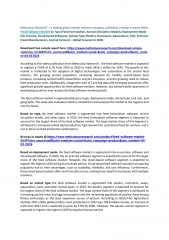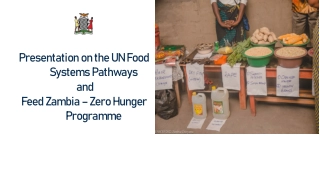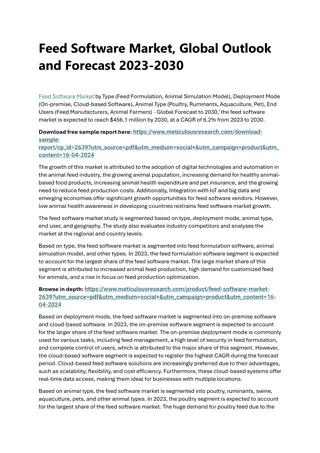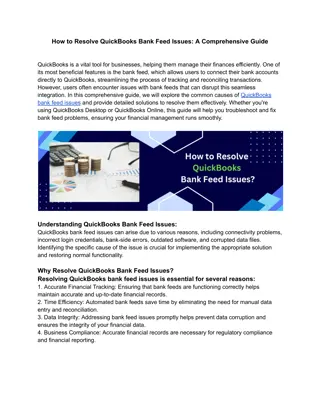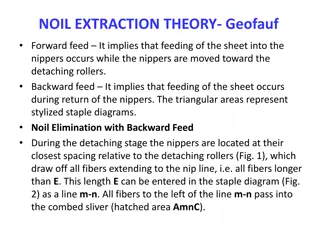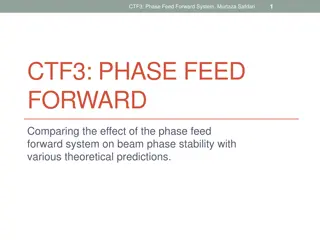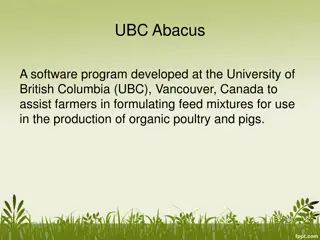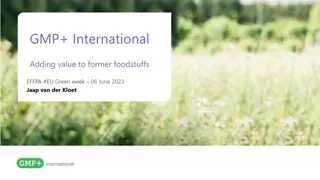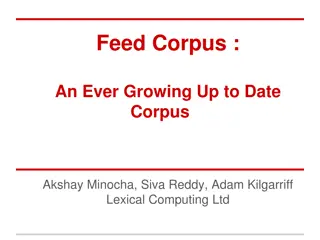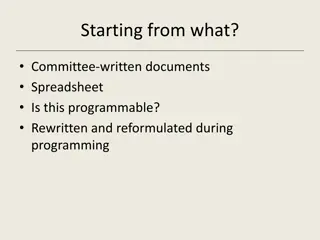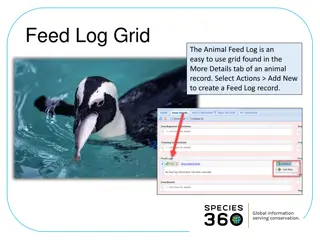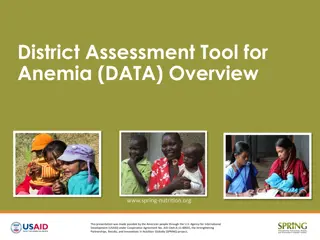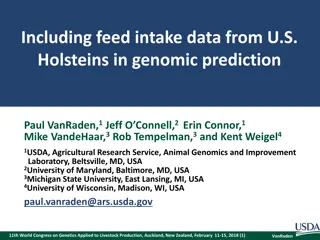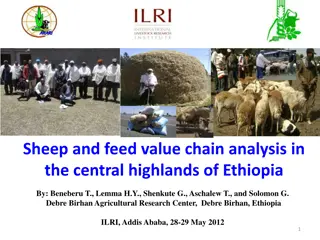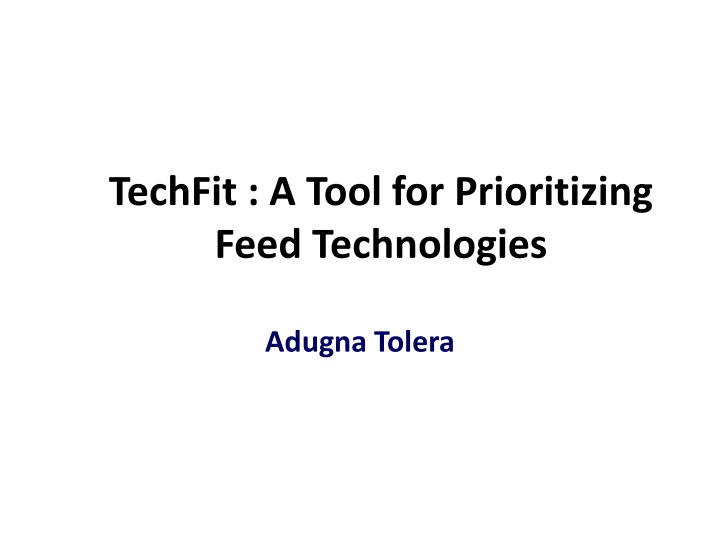
TechFit: A Tool for Prioritizing Feed Technologies and Improving Adoption Rates
TechFit is a valuable tool designed to aid in prioritizing feed technologies for livestock production. It addresses the challenges of poor adoption rates by filtering and matching technology attributes with context attributes, ultimately providing a better understanding of technology effectiveness. By combining scores of technology and context attributes, TechFit helps identify suitable technologies for evaluation and screening, enhancing the likelihood of adoption in local farming contexts.
Download Presentation

Please find below an Image/Link to download the presentation.
The content on the website is provided AS IS for your information and personal use only. It may not be sold, licensed, or shared on other websites without obtaining consent from the author. If you encounter any issues during the download, it is possible that the publisher has removed the file from their server.
You are allowed to download the files provided on this website for personal or commercial use, subject to the condition that they are used lawfully. All files are the property of their respective owners.
The content on the website is provided AS IS for your information and personal use only. It may not be sold, licensed, or shared on other websites without obtaining consent from the author.
E N D
Presentation Transcript
TechFit : A Tool for Prioritizing Feed Technologies Adugna Tolera
Objectives To have a common understanding, interpretation and application of the tool To learn how to score and match technology attributes and context attributes of farmers To customize the application of the tool to the local context
Background Reality No. 1 (Reality of farmers) Livestock production is important Feed is a major constraints (FEAST & Other reports) Farmers are looking for a remedy to the problem Reality No. 2 (Reality of research & development efforts) Various feed technologies generated by the research system Lack of systematic approach for prioritizing available feed technologies Poor adoption rate of available technologies Wastage of substantial efforts and resources
Feed interventions often do not work why? Failure to place feed in broader livelihood context Lack of farmer design and ownership Neglect of how interventions fit the context: land, labour, cash, knowledge etc FEAST Techfit
What is TechFit? A discussion tool for prioritizing feed technologies Helps to identify suitable technologies for evaluation and screening Designed to filter best bet technologies from a basket of technologies available to farmers Provides better understanding of why and why not technologies work or do not work
How does it work? Technology options to address feed problem (list of potentially available technologies) Technologies are filtered at different levels Only technologies with high total scores carried forward to the main filter
How does it work? (Cont ) Main filter involves combining scores of technology and context attributes to arrive at total score Technology attributes requirement of a given technology for land, labor, cash/credit, inputs and knowledge High score => low likelihood of adoption Context attributes availability of land, labor, cash/credit, inputs and knowledge High score => high likelihood of adoption
Match farmers context to technology Score (1-5) for technology attribute Land (1-5) Labor (1-5) Credit (1-5) Input (1-5) Knowledge (1-5) Total score Rank Score (1-5) for context attribute X X X X X Land (1-5) Labor (1-5) Credit (1-5) Input (1-5) Knowledge (1-5) = = = = = = ? If technology demands land => low score for land If farmers do not have or have very small land holding => Low score for land
Technology filter Score the pre-selected technologies based on the requirement, availability and scope for improvement of five technology attributes III. TECHNOLOGY FILTER (Technology options to address quantity, quality, seasonality issues) Pre-select the obvious (5-6) based on context relevance and impact potential Scope for improve ment of attribute s Attribute 5: Knowledge /skill Attribute 1: Land Labour Attribute 2: Attribute 3: Cash /credit Attribute 4: Input delivery Total Score Context relevanc e (score 1- 6; low- high)) Impact potential (score 1- 6; low- high) Total score (context X impact) Requ Score 1-3 (1 for more; 3 for less) Avail Score 1-3 (1 for less; 3 for more) Requ Score 1-3 (1 for more; 3 for less) Avail Score 1-3 (1 for less; 3 for more) Requ Score 1-3 (1 for high; 3 for low) Avail Score 1-3 (1 for less; 3 for more) Requ Score 1-3 (1 for high; 3 for low) Avail Score 1-3 (1 for less; 3 for more) Requ Score 1-3 (1 for high; 3 for low) Avail Score 1-3 (1 for less; 3 for more) Score 1-5 (1 for less and 5 for more) Urea treatment of straw Supplement with UMMB By-pass protein feed Feed conservation (surplus) (HAY) etc etc 2 3 6 3 2 2 2 2 0 2 5 10 3 3 3 2 1 1 1 1 3 1 2 22 1 3 3 3 3 1 1 3 0 4 3 12 3 3 2 2 3 3 3 3 3 3 1 41
How to do scoring and ranking? List of potential technologies obtained from the research system Context relevance and impact potential by experts at each specific location Technology attributes (requirement of the technology for land, labor, etc. ) by experts Context of farmers (availability of land, labor etc.) by farmers (interview a group of representative farmers and ask them to score)
Cost benefit analysis Short list the best 3-4 technologies for cost- benefit analysis What does the technology cost? (type of feed, amount used, % of total feed, cost, % of total feed cost) What does the technology deliver? (animal performance measure, % contribution to the performance change, % contribution to income gain) Is it worthwhile?
Cost-benefit analysis Method not yet well developed and refined Mostly based on a number of assumptions using partial budget analysis Compare additional costs and additional benefits i.e. marginal benefits
Intervention name Clear description focusing processes and actions with pictures and glossary for specific terms Technical Information Key technology attributes Land area required Labour, including gender Skills/Knowledge Cash/Credit External inputs Capital / infrastructure Benefits Applicability Purpose / Addresses constraints opportunities Which animal? Agroecological, farming system suitability including socio-cultural issues (e.g., taboos) if applicable Scale History of use Potential to integrate with (=conclusion: simplicity, observability, use, etc. Primary (including time dimension, etc.) Secondary Adoptability characteristics
Adoptability Protocol - Process Past experiences regarding introduction of technologies, including uptake, community feeling, etc. Ranking of livelihood ambitions/aspirations in general and for agriculture and livestock in particular After becoming more and more reductionist and analytical, bring it back into the broader perspective Objective Subjective FGD on options Give info on options Ask community to rank Discuss ranking, why , etc. (guiding points/questions) Link to CBA data Select trial farmers for AR (model or pioneer farmers)
Factor Guiding points/questions to keep in mind in FGD Relative advantage superiority CBA analysis, but subjective points may be raised in group Quality of labour (drudgery), etc. Riskiness - technology, risk aversion Social acceptability &/or taboos Effect on gender aspects or child labour Possibility of adapting to or in local situation Compatibility Complexity Relatable to something simple, familiar, routine, etc. Trialability Resources present for implementation Observability (Should perhaps be made as Techfit filtre) Competence, capacity & buy-in of local extension staff Enabling environment Delivery process
Data we need to derive from FEAST to feed into Techfit Main constraint Seasonality Quantity Quality Dominant commodity Beef Dairy Sheep/Goats Pigs/poultry Farming system Pastoral Agro-pastoral/mixed Intensive/mixed (crop-livestock) Landless Core context attributes Requirement for land Requirement for labour Requirement for cash credit Requirement for inputs Requirement for knowledge/skills
Seasonality Consult seasonal calendar estimate proportion of minimum availability to maximum availability 1.0 = 0 >0.75 = 1 >0.5 = 2 >0.25 = 3 >0.0 = 4 Is minimum in the dry/winter season? Winter season scarcity Is minimum in the growing season? Growing season scarcity
Quantity If you place more basal feed in front of your animals would they consume it? With extreme enthusiasm = 4 With considerable interest = 3 With some interest = 2 Yes but not immediately = 1 No = 0 Something also about interest in supplemental/high quality feed?
Quality If you placed more basal feed in front of your animals would they consume it? With extreme enthusiasm = 0 With considerable interest = 1 With some interest = 2 Yes but not immediately = 3 No = 4
Commodity focus On a scale from 1 to 10 how important are the following enterprises to cash income: Beef Fattening Breeding stock Dairy Sheep/Goats Fattening Breeding stock Pigs/poultry 0-2 = 0 2-4 = 1 4-6 = 2 6-8 = 3 8-10 = 4
Farming system Which of the following best describes the target group: Pastoral Agro-pastoral/mixed Intensive/mixed (crop-livestock) Landless
Experiences in testing and application of the tool Tested to prioritize feed technologies for 3 different commodities (dairy, beef, sheep) in different parts of Ethiopia Preceded by assessment of livestock production and feeding systems using Feed Assessment Tool (FEAST) Enabled rapid prioritization and short listing of potential feed technologies The pre-filter (context relevance score) helped a great deal to focus attention on those technologies that are relevant in the area.
Strengths of the tool Enables rapid location specific prioritization and short listing of feed technologies in different agro- ecologies and production systems Puts feed in a broader context and filters technologies for specific contexts (agro-ecology, production system, farmers contexts etc.) It is robust in screening out technologies that are not relevant in a given context Gives good indication why some technologies are not easily adopted
Limitations of the tool All scores are based on subjective judgments. Thus one has to be well versed with the subject matter and the local conditions to give a realistic score. Cost benefit analysis is based on a number of assumptions and the validity depends on the soundness of each assumption. Most feed technologies make only partial contribution to the total diet a challenge of partitioning the contribution of the feed in question to the performance of the animal

